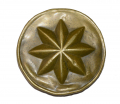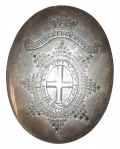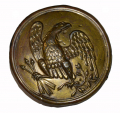site search
online catalog
Buckles/Plates
Showing 21 to 40 out of 115
CIVIL WAR VETERAN’S G.A.R. OFFICER’S BELT
This white bullion embroidered belt uses a Civil War M1851 officer’s sword belt plate and hasp. Chances are that it was worn by an officer in the G.A.R., the largest and best known of the Civil War… (172-6148). Learn More »
FOOT ARTILLERY BELT WITH NOTE
Brown buff leather belt in good condition. Leather is a little dry causing the inside seam in one small section to split but the rest is solid. Belt plate and keeper have matching benchmark numbers of… (344-915). Learn More »
$1,250.00
Originally $1,575.00
TWO-PIECE NAVY OFFICER'S BUCKLE
This belt buckle is US and is of Civil War vintage. It could be US Navy, Marine or Mercantile Navy etc. so it should be referred to as "Sea Service". It is certainly martial in style and made of cast… (2025-799). Learn More »
$250.00
ON HOLD
US PATTERN 1839 CARTRIDGE BOX PLATE (FROM FIRE?)
This Federal cartridge box plate is of the regulation 1839. Constructed in the die-struck and rolled brass method, the brass accoutrement’s face shows a clear “US” with an unusual copper tone on… (2025-1141). Learn More »
$65.00
ON HOLD
RARE CIVIL WAR WAIST BELT PLATE
This die-struck and lead filled oval plate measures just over 2 inches in diameter. It has iron wire belt hooks on the back. The motif on the front is an 8-pointed star. The eight-pointed star has… (2025-815). Learn More »
REGULATION NCO SHOULDER BELT FOR SWORD AND BAYONET WITH REPRO EAGLE PLATE
Offered is an original Civil War-era leather shoulder belt set up to hold the sword and bayonet of non-commissioned officers. It comes with a reproduction 1826 Eagle plate. This adjustable shoulder… (2025-2037). Learn More »
$395.00
ON HOLD
CONFEDERATE MOVABLE TONGUE, WISHBONE FRAME BUCKLE
One of the more distinctive Confederate belt buckles is the frame pattern, which comes in several styles with fixed and movable tongues in different shapes and configurations. This is the classic… (2025-2544). Learn More »
U.S. M1851 NCO SWORD BELT WITH PLATE & STRAPS FOR MOUNTED ARTILLERY
Bridle leather sword belt in good condition. The exterior leather surfaces show moderate surface crazing with scattered patches of flaking and loss. The leather belt is strong and supple with no weak… (490-7401). Learn More »
VIRGINIA OFFICER’S BELT PLATE REMOVED FROM THE BODY OF COL. JAMES G. HODGES, 14th VIRGINIA, KILLED IN PICKETT’S CHARGE, WITH HIS COLONEL’S STARS- THE PLATE RETURNED TO HIS WIDOW IN 1903!
This historic group includes the Virginia Confederate officer’s sword belt plate removed from the body of Colonel James Gregory Hodges, 14th Virginia, Armistead’s brigade, killed at the stone wall… (846-563). Learn More »
$25,000.00
Originally $29,500.00
1839 PATTERN U.S. INFANTRY WAIST BELT PLATE ON A WHITE BUFF LEATHER BELT
Standard issue 1839 pattern enlistedman’s white buff leather belt with a typical, large US buckle. The belt is 1.75” wide and approximately 38” long. The leather shows light use, with the… (490-7405). Learn More »
MODEL 1851 NCO WAIST BELT WITH BELT PLATE
Civil War era non-commissioned officer’s belt buckle on original bridle leather waist belt. Cast brass eagle buckle which has a one-piece applied German silver wreath and has the narrow 0.5” wide… (490-7404). Learn More »
M1851 ENLISTED MAN’S SWORD BELT - KNOX FAMILY, FREDERICKSBURG, VA
This model 1851 enlisted man’s sword belt came from the collection of Civil War relics and family mementos retained by the Knox family of Fredericksburg, VA. The family was large, prosperous, and… (1262-01). Learn More »
RARE WHEN ON LEATHER (COMMON) CONFEDERATE "WISHBONE" BUCKLE
Our Mr. Steven Roger's writes, "One of the more distinctive Confederate belt buckles is the frame pattern with a movable spit tongue sometimes called the “forked tongue” or “wishbone” pattern.… (1268-017). Learn More »
FRENCH HORSE ARTILLERY 3-PIECE BELT PLATE
This silver(ed) bronze buckle is the rare "Modèle d'août 1830" a design created during "The July Monarchy". In 1830, the discontent caused by Charles X’s authoritarian policies culminated in an… (2025-959). Learn More »
BRITISH STERLING SILVER ROYAL HOUSEHOLD OR LIVERY SWORD BELT PLATE
Made for a uniformed Royal servant of King George III by Peter Carter of London, England in 1794. The plate is beautifully hand engraved with the Order of the Garter and motto: "HONI SOIT QUI MALY… (2025-845). Learn More »
MARYLAND SWORD BELT PLATE
These plates follow the general configuration of the U.S. M1851, but substitute the 1854 version of the Great Seal of Maryland, simply moving the motto from a ribbon scroll at the bottom to the top of… (2025-767). Learn More »
EAST WOODS ANTIETAM RECOVERED M1855 RIFLEMAN’S BELT BUCKLE AND LOOPS
This brass hardware from an 1855 pattern rifleman’s was recovered in the East Woods on the battlefield of Antietam. These belts were copies of the French 1847 pattern for the “Chasseurs a Pied,”… (490-7363). Learn More »
$395.00
ON HOLD
NON-DUG, U.S. PATTERN 1826 EAGLE BREAST PLATE
This US shoulder belt plate was to be affixed to the front of the shoulder belt for the infantry cartridge box. It features a brass face featuring a raised spread-winged eagle design. Brass face shows… (2025-805). Learn More »
POST-CIVIL WAR OHIO SWORD BELT PLATE
The plate is cast brass and rectangular in shape with the Ohio coat of arms at center. The detail of the mountains with the rising sun and the canal boat are excellent. Surrounding this central design… (2025-800). Learn More »
MAINE VOLUNTEER MILITIA CARTRIDGE BOX PLATE
This is an excavated VMM box plate. These plates were patterned after the U.S. box plate, but were stamped VMM for Volunteer Militia of Maine, and are thought to have been issued to Maine’s ten… (2025-762). Learn More »
Showing 21 to 40 out of 115
Most Popular
Historical Firearms Stolen From The National Civil War Museum In Harrisburg, Pa »
Theft From Gravesite Of Gen. John Reynolds »
Selection Of Unframed Prints By Don Troiani »
Fine Condition Brass Infantry Bugle Insignia »
Large English Bowie Knife With Sheath 1870’S – 1880’S »
Imported (Clauberg) Us Model 1860 Light Cavalry Officer's Saber »
featured item
NEAR EXCELLENT CONDITION COLT M1851 NAVY
A near excellent Middle Fourth Model Colt M1851 Navy, with all-matching serial number 141159, to which the Colt site assigns an 1863 production date. This model falls in the #118000-#16800 range, overlapping with earlier and particularly later… (302-123). Learn More »






















